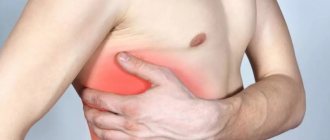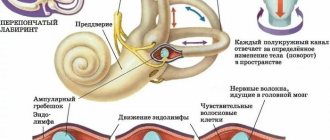Restless legs syndrome
The basic clinical symptoms are sensory (sensitive) disorders in the form of dys- and paresthesia and motor disorders in the form of involuntary motor activity. These symptoms affect mainly the lower extremities and are bilateral, although they can be asymmetrical. Sensory disorders appear at rest in a sitting position, and more often - lying down. As a rule, their greatest severity is observed in the period from 0 o'clock to 4 o'clock in the morning, and the least - in the interval from 6 o'clock to 10 o'clock in the morning. Patients are concerned about various sensations in the legs: tingling, numbness, pressure, itching, the illusion of “goosebumps running down the legs” or the feeling that “someone is scratching.” These symptoms are not acutely painful, but are very uncomfortable and painful.
Most often, the initial site of sensory impairment is the legs, less often the feet. As the disease develops, paresthesia covers the thighs and can occur in the arms, perineum, and in some cases on the torso. At the onset of the disease, discomfort in the legs appears after 15-30 minutes. from the moment the patient went to bed. As the syndrome progresses, their onset occurs earlier, even during the daytime. A distinctive feature of sensory disorders in RLS is their disappearance during the period of physical activity. To relieve discomfort, patients are forced to move their legs (bend-unbend, turn, shake), massage them, walk in place, and move around the room. But often, as soon as they lie down again or stop moving their legs, the unpleasant symptoms return again. Over time, each patient develops an individual movement ritual that allows them to most effectively get rid of discomfort.
About 80% of patients with Ekbom syndrome suffer from excessive motor activity, episodes of which bother them at night. Such movements are of a stereotypical, repetitive nature and occur in the feet. They represent the dorsiflexion of the big toe or all the toes, their extension to the sides, flexion and extension of the entire foot. In severe cases, flexion-extension movements in the knee and hip joints may be observed. An episode of involuntary motor activity consists of a series of movements, each of which takes no more than 5 s, the time interval between series is on average 30 s. The duration of the episode varies from several minutes to 2-3 hours. In mild cases, these movement disorders go unnoticed by the patient and are detected during polysomnography. In severe cases, motor episodes lead to night awakenings and may occur several times during the night.
The consequence of sensorimotor disorders that occur at night is insomnia. Due to frequent awakenings at night and difficulty falling asleep, patients have poor sleep and feel groggy after sleep. During the day, they experience decreased performance, the ability to concentrate suffers, and fatigue occurs. As a result of sleep disturbances, irritability, emotional lability, depression, and neurasthenia may occur.
Causes
There are two forms of restless legs syndrome: primary syndrome, as well as manifestations of a disease - secondary restless legs syndrome. According to statistics, restless legs syndrome occurs to one degree or another in approximately 1% of the population or even more. However, most cases remain undiagnosed, since the severity of the manifestations is small and does not lead to a decrease in quality of life, and in this case, patients prefer not to consult a doctor for help. In more than half of the cases, it is a primary syndrome - an idiopathic familial form, in which clinical manifestations develop in patients in the 2-3 decade of life. Neurological examination, as a rule, does not reveal organic pathology, and there are no other reasons for the development of the syndrome. Secondary syndrome often occurs with abuse of coffee and other tonic drinks, with uremia caused by chronic renal failure, and is sometimes an unpleasant complication of pregnancy.
In children, restless legs syndrome can be a sign of hyperactivity and overstimulation. In this case, treatment, as a rule, is not required; dynamic observation should only be carried out.
Diagnostics
Before determining how to treat hyperkinesis, it is necessary to conduct an accurate and reliable diagnosis. At the same time, attention is paid to the clinical picture of the disease, assessment of the psychological and intellectual state of the patient.
In the diagnosis of hyperkinesis the following are used:
- general and biochemical blood tests - diagnose pathology resulting from toxic effects;
- CT and MRI of the brain - detect tumors and various degenerative changes;
- electroencephalography – determines brain activity, diagnoses epilepsy;
- study of cerebral blood flow, ultrasound examination of the vessels of the brain and neck;
- cerebrospinal fluid examination.
Some patients are prescribed genetic counseling. It is necessary if there is a suspicion that hyperkinesis is a symptom of hereditary diseases.
Diagnosing hyperkinesis is a long process that will take several weeks. Determining the causes of pathology will make it possible to treat hyperkinesis more effectively.
General symptoms
The main symptoms of hyperkinesis include motor acts performed by patients against their will, the so-called violent ones. Patients themselves describe them as the result of an irresistible desire that they cannot resist.
The list of symptoms representing hyperkinesis includes:
- frequent blinking and squinting of the eyes (tics);
- convulsive tilting or turning of the head;
- tremor of various parts of the body, most often the limbs;
- myoclonus – sudden muscle twitching of the arms or neck;
- chorea - arrhythmic movements of facial expressions, involuntary sounds arising from rapid contractions of the muscles of the larynx;
- ballism - sudden rotation of the hip or shoulder;
- Blapharospasm is a pathological closure of the eyelids, as one of the signs of various diseases.
Forms of hyperkinesis can vary from intermittently frequent to constant. Some patients manage to control certain forms of hyperkinesis (for example, tics) by force of will, but after a while the attack of violent movements manifests itself again with even greater force.
Pathogenesis
The effectiveness of dopaminergic drugs and the possibility of worsening symptoms under the influence of antipsychotics indicate that a key element in the pathogenesis of RLS is a defect in dopaminergic systems. The clear daily rhythm of clinical manifestations of RLS may reflect the involvement of hypothalamic structures, in particular the suprachiasmatic nucleus, which regulates the daily cycles of physiological processes in the body.
It is possible that in some patients with RLS, polyneuropathy, iron deficiency, coffee abuse or other factors only reveal an existing hereditary predisposition, which partly blurs the line between idiopathic and symptomatic variants of RLS.
Additional techniques
As a complement to drug therapy and proper lifestyle in the treatment of Ekbom syndrome, physiotherapeutic procedures are used, which include:
- Vibromassage.
- Reflexology is a method in which special needles are inserted into specific points on the body.
- Magnetotherapy is the use of magnetic fields that have anti-inflammatory, analgesic and decongestant effects.
- Darsonvalization of the legs - using a special device, a high-frequency, rapidly decaying current is applied to a certain part of the body.
- Lymphopress is the creation of pressure on the lymphatic system in order to normalize metabolic processes in the body and increase the tone of the veins of the lower extremities.
- Mud applications are a method using therapeutic mud. When used, blood circulation improves, the movement of red blood cells improves, and metabolism is normalized.
Types of hyperkinesis
There are various criteria that are used to classify pathology. Thanks to them, the following types of hyperkinesis can be distinguished:
- childhood forms - hyperkinesis up to one year, in the age category from one to five, during puberty;
- by type of occurrence - spontaneous, reflex (reaction to external phenomena), actional (provoked by a certain condition), induced (can be controlled by the patient);
- along the flow – constant (tremors) and episodic (tics);
- by speed of movement - fast and slow;
- by localization - hyperkinesis of the face, limbs, tongue;
- by origin - a distinction is made between primary (congenital) and secondary hyperkinesis acquired as a result of injury or taking medications.
Hyperkinesis in cerebral palsy in children begins to appear at the age of 1.5-2 years. Children with this pathology have difficulty coordinating their movements, which often look like pushing, jerking and twisting. Repetitive movements can be fast and rhythmic or, conversely, slow and erratic.
Hyperkinesis in cerebral palsy may be accompanied by swallowing disorders, speech delays and disorders, and lability of the emotional system.
Why does this disease occur?
During pregnancy, this problem can be caused by several reasons. The appearance of symptoms in the 3rd or 2nd trimester is influenced by the following factors:
- stagnation of blood in the vessels;
- poor sleep caused by dopamine fluctuations or increased estrogen levels;
- lack of iron or folic acid in the body of a pregnant woman;
- increased sensitivity;
- hormonal changes, etc.
The disease is often provoked by pathologies such as Parkinson's disease, diabetes mellitus, rheumatoid arthritis, renal failure, etc.
Treatment
Dopaminergic drugs (levodopa drugs, antiparkinsonian drugs) can alleviate the patient's condition to a greater extent. The drugs used are madopar, nacom, sinemet and others. The dosage of the drug madopar should be from 62.5 to 500 mg, take it an hour before bedtime; in case of severe manifestations, it is necessary to take the drug in a smaller dose immediately before bedtime. Drugs from the group of dopamine receptor agonists (in particular, pramipexole) can be used.
Benzodiazepines (clonazepam, temazepam) can also be used, but their use is limited by the potential for addiction. Therefore, courses of such medications should be short and episodic.
Less often they resort to valproic acid, beta-blockers, and clonidine. Also, many researchers recommend in some cases the use of drugs to relieve neuropathic pain - tebantin, Lyrica, etc.
Non-drug treatment methods are also important. Among them, the following types of therapy are worth noting:
- Dosed physical activity on the lower limbs before bedtime. This technique allows you to moderately tire the leg muscles, thereby reducing the threshold for muscle excitation.
- Foot massage before bed.
- Hot or, conversely, cold foot baths before bed.
- Limiting psycho-emotional stress, factors that can lead to sleep disorders. After all, sleep disturbances themselves can be a trigger for the development of restless legs syndrome.
All these methods, in combination with recommended drug therapy, can achieve significant improvement in most cases, and in some cases, long-term spontaneous remission.
Traditional methods, which have been actively advertised recently, can only be used as additional therapy. Recipes for light sedatives and other folk methods aimed at producing a sedative effect will be useful.







